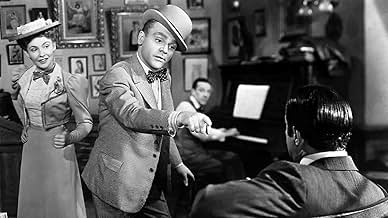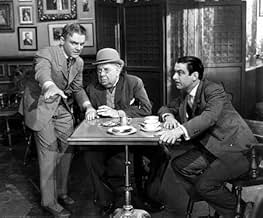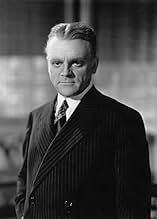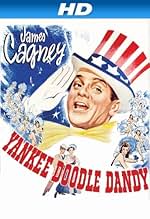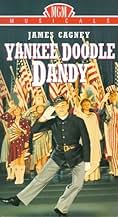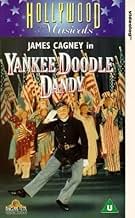AVALIAÇÃO DA IMDb
7,6/10
18 mil
SUA AVALIAÇÃO
A vida do renomado compositor musical, dramaturgo, ator, dançarino e cantor George M. Cohan.A vida do renomado compositor musical, dramaturgo, ator, dançarino e cantor George M. Cohan.A vida do renomado compositor musical, dramaturgo, ator, dançarino e cantor George M. Cohan.
- Direção
- Roteiristas
- Artistas
- Ganhou 3 Oscars
- 9 vitórias e 6 indicações no total
Patsy Parsons
- Josie Cohan - As a Girl of 12
- (as Patsy Lee Parsons)
Avaliações em destaque
James Cagney won his only Oscar for his recreation of George M. Cohgan in Yankee Doodle Dandy. Already terminally ill, Cohan lived long enough to see the film and no doubt he would have approved of it because it sure is how he would like to have been remembered.
In 1942 when Yankee Doodle Dandy premiered there was a whole generations of people left alive who saw George M. Cohan perform. Watching the film today Cohan is like a figure from antiquity. But Warner Brothers was lucky to have James Cagney with the studio who's dancing style closely paralleled Cohan's. If it is ever run on Turner Classic Movies, make sure you see George M. Cohan's sound film The Phantom President. You will be astonished to see how closely Cagney captured his style. In the same way that Philip Seymour Hoffman captured Truman Capote and Joaquin Phoenix became Johnny Cash.
Cohan's contemporaries are also like names from antiquity. But a century ago when Cohan was just hitting the big time performers like Fay Templeton, Nora Bayes, and Eddie Foy were very big stars and in 1942 plenty of people saw them also. I wish we had some film of them to see how Irene Manning, Frances Langford, and Eddie Foy, Jr. did in their recreations. I'm sure Foy, Jr. did a smashing job with his Dad.
The background stuff is true enough. Cohan was born to a pair of vaudeville performers Jerry and Nellie Cohan played here by Walter Huston and Rosemary DeCamp. Later on a sister was added to the Cohan family and here Josie Cohan is played by Jeanne Cagney. They did do all the towns, big and small, in America. Cagney meets wife Joan Leslie at Shea's Theater in Buffalo, New York and Shea's survives to this day. And his first real success was Little Johnny Jones which score included American classics, Yankee Doodle Dandy and Give My Regards to Broadway.
What's left out is the fact Cohan had two wives. His second wife survived him and died in the early Seventies. As his songs became popular in patriotic/rightwing circles, Cohan's personal politics reflected that. He fought hard and lost in the battle for Actors Equity. Cohan thought a union of players was tantamount to Communism. But such was his standing among performers that Cohan was granted the unique privilege of being allowed to appear on stage without having to join Equity once the union was recognized as the bargaining agent for players.
Cohan is shown in Yankee Doodle Dandy as gracefully having retired when other trends in popular music took over. Far from it, he was a very bitter man and when he did that final comeback in I'd Rather Be Right he fought with Kaufman and Hart over the book and Rodgers and Hart over the songs.
But Yankee Doodle Dandy presents the public musical face of George M. Cohan and does it very well. To this day, some forty years after first seeing Yankee Doodle Dandy on television, I love the recreations of Yankee Doodle Dandy, Give My Regards to Broadway, and You're a Grand Old Flag as they were first seen on stage. Plus some of the snatches of the lesser known Cohan songs as performed by the players portraying the Cohan family and others.
When all is said and done, George M. Cohan was a great force of nature in the American musical theater. And we thank his father, mother, and sister, and George M. himself for what he left us.
In 1942 when Yankee Doodle Dandy premiered there was a whole generations of people left alive who saw George M. Cohan perform. Watching the film today Cohan is like a figure from antiquity. But Warner Brothers was lucky to have James Cagney with the studio who's dancing style closely paralleled Cohan's. If it is ever run on Turner Classic Movies, make sure you see George M. Cohan's sound film The Phantom President. You will be astonished to see how closely Cagney captured his style. In the same way that Philip Seymour Hoffman captured Truman Capote and Joaquin Phoenix became Johnny Cash.
Cohan's contemporaries are also like names from antiquity. But a century ago when Cohan was just hitting the big time performers like Fay Templeton, Nora Bayes, and Eddie Foy were very big stars and in 1942 plenty of people saw them also. I wish we had some film of them to see how Irene Manning, Frances Langford, and Eddie Foy, Jr. did in their recreations. I'm sure Foy, Jr. did a smashing job with his Dad.
The background stuff is true enough. Cohan was born to a pair of vaudeville performers Jerry and Nellie Cohan played here by Walter Huston and Rosemary DeCamp. Later on a sister was added to the Cohan family and here Josie Cohan is played by Jeanne Cagney. They did do all the towns, big and small, in America. Cagney meets wife Joan Leslie at Shea's Theater in Buffalo, New York and Shea's survives to this day. And his first real success was Little Johnny Jones which score included American classics, Yankee Doodle Dandy and Give My Regards to Broadway.
What's left out is the fact Cohan had two wives. His second wife survived him and died in the early Seventies. As his songs became popular in patriotic/rightwing circles, Cohan's personal politics reflected that. He fought hard and lost in the battle for Actors Equity. Cohan thought a union of players was tantamount to Communism. But such was his standing among performers that Cohan was granted the unique privilege of being allowed to appear on stage without having to join Equity once the union was recognized as the bargaining agent for players.
Cohan is shown in Yankee Doodle Dandy as gracefully having retired when other trends in popular music took over. Far from it, he was a very bitter man and when he did that final comeback in I'd Rather Be Right he fought with Kaufman and Hart over the book and Rodgers and Hart over the songs.
But Yankee Doodle Dandy presents the public musical face of George M. Cohan and does it very well. To this day, some forty years after first seeing Yankee Doodle Dandy on television, I love the recreations of Yankee Doodle Dandy, Give My Regards to Broadway, and You're a Grand Old Flag as they were first seen on stage. Plus some of the snatches of the lesser known Cohan songs as performed by the players portraying the Cohan family and others.
When all is said and done, George M. Cohan was a great force of nature in the American musical theater. And we thank his father, mother, and sister, and George M. himself for what he left us.
Right from the start, I have to say you do not need to be an American to be caught up in the excitement of the blatant flag waving tribute to a great artist. "Yankee Doodle Dandy" made to boost morale after the U.S. entered the war surely would have achieved its goal. It would have been even better in Technicolor (not the coloured version later shown). The songs were great, the acting and the individual dancing style of James Cagney was superb and deserved the Oscar. The two scenes featuring "Over There" were very moving with Frances Langford a standout! The story, while bearing small resemblance to real life, was good and Walter Huston and Rosemary de Camp were excellent. When you see a film such as this some 60 years after its release, and still really enjoy it, it shows how the Golden Years of Hollywood were just that.
James Cagney recalls in his autobiography that this movie was his favorite, largely due to his love of dancing. He was one of the great "tough guys" of all time on film, but dancing was his passion, he noted. It shows here. This was "a labor of love," to use a cliché, and it's obvious how much fun he was having in this film. His hoofing talent also was obvious. He was good, very good.
In fact, for the audience, most of this movie is pure "feel good." Almost all the characters are nice people, the story is inspirational and nicely patriotic and the songs are fantastic. If you pick up the two-disc special-edition DVD that came out several years ago, then you'll see this film in all it's glory. The transfer is magnificent and really brings out the great cinematography. I never realized how beautifully filmed this was until I saw this on DVD.
The story is simply the biography of George M. Cohan, the writer and Broadway star of many, many hit plays and hit songs. Unlike today's biographies, this is a very positive story about a man who brought patriotism alive during World War I with such inspirational songs as "It's A Grand Old Flag" and "Over There." For some of us, listening to these songs can bring a tear or two.
Cagney is his normal riveting self and Joan Leslie certainly makes an appealing female lead as Cohan's wife. The great Walter Huston plays Cohan's father. I've always found Huston to be an actor of great presence. In this movie is a very, very touching deathbed scene with he and Cagney.
So you have a little bit of everything here from drama to romance to comedy to music and Cagney is the glue to fits it all together beautifully. One of the great classic films of all time.
In fact, for the audience, most of this movie is pure "feel good." Almost all the characters are nice people, the story is inspirational and nicely patriotic and the songs are fantastic. If you pick up the two-disc special-edition DVD that came out several years ago, then you'll see this film in all it's glory. The transfer is magnificent and really brings out the great cinematography. I never realized how beautifully filmed this was until I saw this on DVD.
The story is simply the biography of George M. Cohan, the writer and Broadway star of many, many hit plays and hit songs. Unlike today's biographies, this is a very positive story about a man who brought patriotism alive during World War I with such inspirational songs as "It's A Grand Old Flag" and "Over There." For some of us, listening to these songs can bring a tear or two.
Cagney is his normal riveting self and Joan Leslie certainly makes an appealing female lead as Cohan's wife. The great Walter Huston plays Cohan's father. I've always found Huston to be an actor of great presence. In this movie is a very, very touching deathbed scene with he and Cagney.
So you have a little bit of everything here from drama to romance to comedy to music and Cagney is the glue to fits it all together beautifully. One of the great classic films of all time.
There are many, many James Cagney films that show his enormous talent as an actor. He was equally at home in musicals, dramas and comedies. While I have always been a fan and appreciate his unusual scope, this movie in particular caught my eye and totally blew me away when the scene I'm about to describe unfolded.
Near the very end of the film Cagney's character (George M. Cohan) bids farewell to the President and leaves the room. There is a long, open staircase he starts walking down. As he walks you sense a bit of a bounce beginning to take over his step.....one that quickly gives way to an awesome dance as he navigates the stairway. Many will not note, but this dance was a fantastic achievement on two fronts. One, it was done in one "take"...that is, the camera never stopped; the scene never "cut." The camera stays with him in one shot all the way through. Second, Mr. Cagney never ONCE looks at his feet or down at the steps. It's almost impossible to WALK down a staircase without looking down or hanging on to a banister....this man DANCED down a staircase without benefit of seeing or touching anything.
Couple this feat with the brilliant display of "hoofing" he gives earlier in the film when he literally dances up the walls and you have a movie that deserves its "classic" rating. If you haven't seen it please make it a point to do so. Any movie that is awe inspiring 62 years later must be worth a peek, don't you agree?
Near the very end of the film Cagney's character (George M. Cohan) bids farewell to the President and leaves the room. There is a long, open staircase he starts walking down. As he walks you sense a bit of a bounce beginning to take over his step.....one that quickly gives way to an awesome dance as he navigates the stairway. Many will not note, but this dance was a fantastic achievement on two fronts. One, it was done in one "take"...that is, the camera never stopped; the scene never "cut." The camera stays with him in one shot all the way through. Second, Mr. Cagney never ONCE looks at his feet or down at the steps. It's almost impossible to WALK down a staircase without looking down or hanging on to a banister....this man DANCED down a staircase without benefit of seeing or touching anything.
Couple this feat with the brilliant display of "hoofing" he gives earlier in the film when he literally dances up the walls and you have a movie that deserves its "classic" rating. If you haven't seen it please make it a point to do so. Any movie that is awe inspiring 62 years later must be worth a peek, don't you agree?
`It seems it always happens
Whenever we get too high hat and sophisticated for flag-waving, some thug nation decides we're a pushover, all ready to be blackjacked. It's not long before we start looking up mighty anxiously to make sure the flag is still waving.'
So says James Cagney, as George M. Cohan, at the time of the sinking of the Lusitania in 1915. Obviously, it's a sentiment that has great relevance to our time, as well. I've always wished I could dance a patriotic dance or march down the street waving the flag. It looks like a lot of fun. The trouble is, this sort of activity is often performed to suppress what America is really about. The really great thing about our country isn't songs, flags and marches. Any country can do those things. The real great thing is that we have the right to say what we think, to debate the issues of the day and to form a consensus for action when we are in agreement about what needs to be done.
There was surely such a consensus when this film was made in 1942. There was little doubt about what needed to be done then. However, World War I seems now a particularly pointless conflict and the thought that smiling Frances Langford was singing soldiers into battle to who knows what fate is a little disturbing. And now, whenever there is a war, we are urged to join the parade and postpone debate until the issue is something not so important, like farm prices or college entrance requirements. It seems to me that the more important an issue is, the more we should be debating it. If people are going to die, we'd better make sure we are right.
From that point of view, `Yankee Doodle Dandy' can seem almost offensive. But, of course it isn't. Is a charming example of one of the thing Old Hollywood did best- the romantic biography. In this George M. is an all-right guy, an enormous bundle of energy that intimidates the stuffed shirts but causes people of substance to fall in love with him. He has a wonderful family and one of those `perfect' Hollywood wives- Mary, who doesn't even wince when he gives the song he wrote for her to another actress. He has a loyal friend and partner in Jed Harris. For some reason he's childless but still gets a thrill from performing for his beloved audiences. And, when his country needs a shot in the arm, his enthusiastic songs provide it.
Of course, he was married twice. His divorce from his first wife Ethel, was acrimonious and thus she doesn't appear in the story. `May' is a fictionalized version of his second wife Agnes. He had children but they also didn't make the cut because he was estranged from them at the time of the film. He was loathed by many of his profession for years before this because of his strong anti-union stance. His split with Jed Harris was not the gentle retirement we see here but was, at least in part because Harris had given in to the unions. And he himself loathed Franklin Roosevelt, refusing for four years to pick up the medal FDR and Congress had awarded him. Would it have been a better movie if these things were incorporated into the script? Probably not. Hollywood- and the nation at the time- was more concerned with the way things should have been than with the way they actually were.
Cagney was surely a perfect choice to play Cohan, being an Irishman who enter show business as a song and dance man, (and always considered himself primarily that). His exuberant personality also mirrors that of Cohan, who was said not to be particularly great at anything but did everything with such enthusiasm that it didn't matter. That said, I have never been a particular fan of Cagney's `puppet on a string' dance style. Dancing is supposed to be an expression of one's inner self. A puppet has no inner self.
There are many charming sequences in the film, none more so than the `cute-meet' with Mary where he's played a dottering old man in a play and she thinks he really is one until he starts showing her dance steps. Then there's his refusal by the Army because of his age. He does another dance routine to show them what they are missing. You've got to love the sequence where he and Harris, (Richard Whorf), con Cuddles Zakal into backing them. Then there's a glimpse of Cagney cute sister, Jeanne, playing Josie, Cohan's sister. We are not told why Josie is `gone' late in the film- her heart attack at age 36 was deemed too unpleasant, as was the death of Cohan's mother, (Rosemary Decamp, who was more than a decade younger than Cagney). The one death scene is that of Cohan's beloved father, played by Walter Huston, who was a Cohan protégé. Chan himself was on his deathbed as this was released, (he submitted a script which was `tactfully rejected'). He escaped his nurse to see it in a theater and gave it his approval, as we should, too.
So says James Cagney, as George M. Cohan, at the time of the sinking of the Lusitania in 1915. Obviously, it's a sentiment that has great relevance to our time, as well. I've always wished I could dance a patriotic dance or march down the street waving the flag. It looks like a lot of fun. The trouble is, this sort of activity is often performed to suppress what America is really about. The really great thing about our country isn't songs, flags and marches. Any country can do those things. The real great thing is that we have the right to say what we think, to debate the issues of the day and to form a consensus for action when we are in agreement about what needs to be done.
There was surely such a consensus when this film was made in 1942. There was little doubt about what needed to be done then. However, World War I seems now a particularly pointless conflict and the thought that smiling Frances Langford was singing soldiers into battle to who knows what fate is a little disturbing. And now, whenever there is a war, we are urged to join the parade and postpone debate until the issue is something not so important, like farm prices or college entrance requirements. It seems to me that the more important an issue is, the more we should be debating it. If people are going to die, we'd better make sure we are right.
From that point of view, `Yankee Doodle Dandy' can seem almost offensive. But, of course it isn't. Is a charming example of one of the thing Old Hollywood did best- the romantic biography. In this George M. is an all-right guy, an enormous bundle of energy that intimidates the stuffed shirts but causes people of substance to fall in love with him. He has a wonderful family and one of those `perfect' Hollywood wives- Mary, who doesn't even wince when he gives the song he wrote for her to another actress. He has a loyal friend and partner in Jed Harris. For some reason he's childless but still gets a thrill from performing for his beloved audiences. And, when his country needs a shot in the arm, his enthusiastic songs provide it.
Of course, he was married twice. His divorce from his first wife Ethel, was acrimonious and thus she doesn't appear in the story. `May' is a fictionalized version of his second wife Agnes. He had children but they also didn't make the cut because he was estranged from them at the time of the film. He was loathed by many of his profession for years before this because of his strong anti-union stance. His split with Jed Harris was not the gentle retirement we see here but was, at least in part because Harris had given in to the unions. And he himself loathed Franklin Roosevelt, refusing for four years to pick up the medal FDR and Congress had awarded him. Would it have been a better movie if these things were incorporated into the script? Probably not. Hollywood- and the nation at the time- was more concerned with the way things should have been than with the way they actually were.
Cagney was surely a perfect choice to play Cohan, being an Irishman who enter show business as a song and dance man, (and always considered himself primarily that). His exuberant personality also mirrors that of Cohan, who was said not to be particularly great at anything but did everything with such enthusiasm that it didn't matter. That said, I have never been a particular fan of Cagney's `puppet on a string' dance style. Dancing is supposed to be an expression of one's inner self. A puppet has no inner self.
There are many charming sequences in the film, none more so than the `cute-meet' with Mary where he's played a dottering old man in a play and she thinks he really is one until he starts showing her dance steps. Then there's his refusal by the Army because of his age. He does another dance routine to show them what they are missing. You've got to love the sequence where he and Harris, (Richard Whorf), con Cuddles Zakal into backing them. Then there's a glimpse of Cagney cute sister, Jeanne, playing Josie, Cohan's sister. We are not told why Josie is `gone' late in the film- her heart attack at age 36 was deemed too unpleasant, as was the death of Cohan's mother, (Rosemary Decamp, who was more than a decade younger than Cagney). The one death scene is that of Cohan's beloved father, played by Walter Huston, who was a Cohan protégé. Chan himself was on his deathbed as this was released, (he submitted a script which was `tactfully rejected'). He escaped his nurse to see it in a theater and gave it his approval, as we should, too.
Você sabia?
- CuriosidadesMany facts were changed or ignored to add to the feel of the movie. For example, the real George M. Cohan was married twice, and although his second wife's middle name was Mary, she went by her first name, Agnes. In fact, the movie deviated from the truth to such a degree that Cohan's daughter Georgette commented, "That's the kind of life Daddy would have liked to have lived."
- Erros de gravaçãoThe "You're A Grand Old Flag" number, supposedly takes place in the 1906 production of "George Washington Jr.," and uses multiple period flags to represent times before 1906. The Civil War flag, as an example, is correct for the time in question. However, in the final sequence characters carry, and an soft screen projection is made of, multiple 48 star flags. The 48 star flag was not introduced until 1912. In 1906, it should have been a 45 star flag. (Oklahoma was admitted to the Union in 1907, New Mexico and Arizona in 1912).
- Citações
George M. Cohan: My mother thanks you, my father thanks you, my sister thanks you, and I thank you.
- Versões alternativasAlso available in a computer colorized version.
- ConexõesFeatured in The Voice That Thrilled the World (1943)
- Trilhas sonorasThe Yankee Doodle Boy
(1904) (uncredited)
from the Broadway Show "Little Johnny Jones"
Written by George M. Cohan
Played during the opening credits
Sung and Danced by James Cagney and Chorus
Principais escolhas
Faça login para avaliar e ver a lista de recomendações personalizadas
- How long is Yankee Doodle Dandy?Fornecido pela Alexa
Detalhes
- Data de lançamento
- País de origem
- Idioma
- Também conhecido como
- Canção da Vitória
- Locações de filme
- Empresa de produção
- Consulte mais créditos da empresa na IMDbPro
Bilheteria
- Faturamento bruto nos EUA e Canadá
- US$ 11.800.000
- Tempo de duração2 horas 6 minutos
- Cor
- Proporção
- 1.37 : 1
Contribua para esta página
Sugerir uma alteração ou adicionar conteúdo ausente




